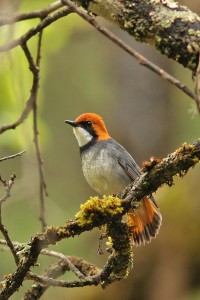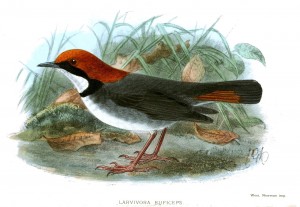Week 34 – 05 March 2017:
One Hundred and Ten Years in the Life of a Chinese Robin
One day you might happen to find yourself travelling on the Northern Line of London’s underground subway system, approaching The Tottenham Court Road station. If someone happens to spill their cappuccino all over your shirt, you could find yourself in need of a new garment. Fear not. You will find a Primark clothing store right across the street from the entrance to the tube station.
That has not always been the case. One hundred and ten years ago, Restaurant Frascati stood where Primark is today. On the 20th of February 1907, forty members of the British Ornithologists’ Club, along with ten guests, gathered at Restaurant Frascati for the 130th meeting of the club. After finishing their dinner and completing the usual business of the club, several members brought out stuffed specimens of some particularly interesting birds. Boyd Alexander displayed six specimens including a male Black-shouldered Nightjar from Africa. Walter Rothschild introduced club members to a stuffed male Dusky-headed Parakeet from Brazil.
Ernst Hartert then brought out a stuffed adult male Rufous-headed Robin, a species that was new to science. The top of its head and the back of its neck were reddish-orange. It had a broad black stripe across its face and around its throat. The rest of the body was varying shades of black, grey and brown. Hartert explained that the specimen had been collected in the Tsin-ling Mountains of northern China, and that three specimens of the species had been deposited in the Natural History Museum’s collection at Tring.
More than a century later, the Rufous-headed Robin remains one of the least-known birds in the world. The International Union for the Conservation of Nature considers the bird to be endangered with a decreasing population. The species has not been observed at the site from which it was first described since its original collection.
When it comes to conservation, that is not sufficient information. Consequently Min Zhao of the Institute of Zoology, Chinese Academy of Sciences, and colleagues endeavored to reveal more about the lives of Rufous-headed Robins, which are found over large parts of Asia. Their findings appeared in a recent publication.
Using DNA from a blood sample collected from an adult male captured in 2015, the team determined that the bird’s closest relative is the widely-distributed Rufous-tailed Robin. Zhao et al. also studied recordings of songs from Rufous-headed Robins, and found them to be most similar to the Ryukyu Robin, a near-threated species from Japan.
In the last twenty-five years, the bird has only been observed in two spots in Sichuan Province. The team considered the habitat and environment of the eight known breeding sites of the Rufous-headed Robin, in the hope that other potential breeding sites of this cryptic species might be revealed. Their modelling suggested that additional breeding sites might be searched for in the mountains of central and northern Sichuan, southern Shaanxi, southern Gansu, and south-eastern parts of Tibet.
We have come a long way since Hartert’s first description of the Rufous-headed Robin. The work of Min Zhao and colleagues revealed new information that may assist in the bird’s long-term conservation. They warned, however, that efforts in China to help this long-distance migrant may not be sufficient. “The fate of the species may depend more on conditions and threats along its migration route and in its wintering quarters.” With only three Rufous-headed Robins ever seen outside of China, two wintering in Malaysia and one migrating through Cambodia, much work remains.
Zhao, M., P. Alström, R. Hu, C. Zhao, Y. Hao, F. Lei, and Y. Qu. 2016. Phylogenetic relationships, song and distribution of the endangered Rufous-headed Robin Larvivora ruficeps. Ibis 159:204-216.
Photo credits: photograph (c) Pete Morris, Birdquest – www.surfbirds.com; painting by John Gerrard Keulemans, from Ibis (1906) – www.wikipedia.com



